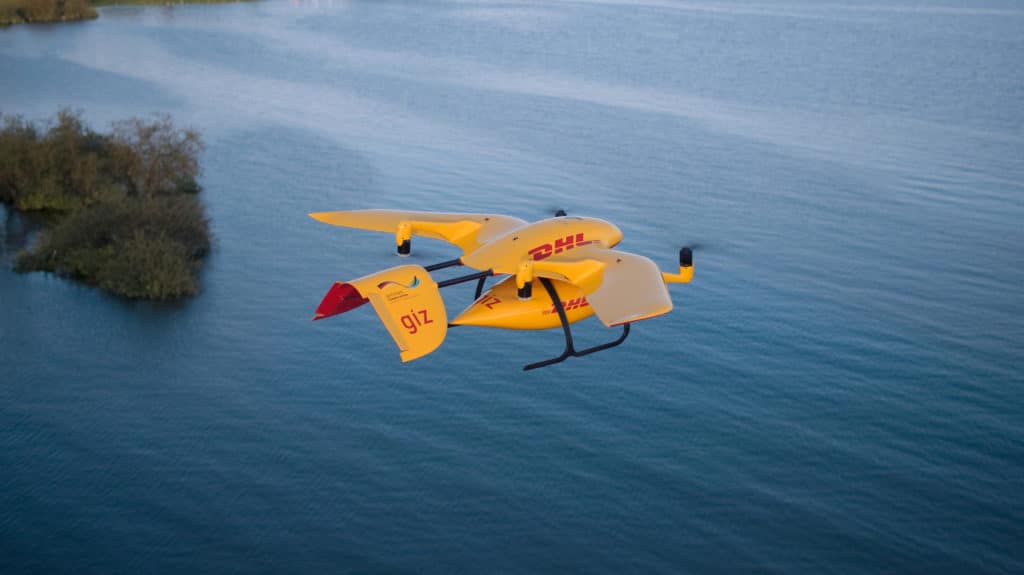Delivery drones have emerged as a fascinating and innovative solution to the challenges of logistics and transportation.
These unmanned aerial vehicles (UAVs) are aircraft that can autonomously transport packages or goods from one location to another. They have captured the attention of industries and consumers alike, offering a glimpse into a future where goods and medical supplies are delivered through the skies.
The increasing demand for faster, more efficient delivery methods has fueled the interest and use of delivery drones. Customers are now accustomed to same-day or even one-hour deliveries, pushing companies to seek innovative solutions.
Although there have been talks of delivery drones since the 2000s, there was no commercial interest in them until the 2010s when companies like Amazon and DHL started exploring the potential of using drones for package delivery.
Jeff Bezos’ announcement of Prime Air in 2013 drew significant attention to the concept, and a wave of advancements in drone technology followed suit. The coming years saw the birth of drone companies like Swoop Aero and Skydio, and the growth of existing ones like DJI and Volocopter.
The use of delivery drones follows a process:
- A customer places an order.
- The fulfillment center packages and labels the goods to be delivered.
- A flight plan (route, waypoints, altitude, and other parameters necessary for safe and efficient delivery) is generated for the drone.
- The drone departs for its destination.
- Once the delivery is made, it returns to its base.
The Technology Driving Delivery Drones
Typical of tech products, delivery drones are a combination of technologies and systems. They are equipped with sensors, GPS navigation, and advanced algorithms that enable them to autonomously navigate routes, avoid obstacles, and safely reach their destinations.
Their key physical aspects include lightweight design with durable materials like carbon fiber composites, electric propulsion systems powered by lithium-ion or lithium polymer batteries, and flight control systems.
Navigation is facilitated by GPS technology, which allows them to determine their precise location, altitude, and velocity. Sensors like cameras, lidar, radar, and ultrasonic sensors enable obstacle detection and avoidance, ensuring safe flight paths.
Connectivity and communication systems enable real-time control and monitoring, while automation and autonomy features allow drones to operate with minimal human intervention.
Security measures like geofencing and safety features such as fail-safe mechanisms and emergency landing procedures are incorporated to mitigate risks and ensure safe operations.
The continuous development and integration of these technologies are driving the advancement of delivery drones, making them more capable, reliable, and efficient for various delivery applications in the logistics and e-commerce sectors.
Advantages of Delivery Drones
Delivery drones bring several advantages that can revolutionize the way goods are transported.
They offer unparalleled speed and efficiency in the delivery process. By flying directly to the destination, they can bypass road congestion and traffic delays, resulting in faster deliveries.
This increased efficiency can be particularly beneficial for time-sensitive goods, such as medical supplies or perishable items.
Another unique aspect of delivery drones is their ability to access remote or hard-to-reach locations.
Unlike traditional transportation, delivery drones can reach areas restricted by a lack of infrastructure, making it possible to deliver essential goods to rural communities.
They also offer a greener alternative to traditional delivery methods. Using electric power and flying directly to destinations, they can reduce carbon emissions associated with traditional vehicles.
Finally, delivery drones can reshape the economics of logistics and supply chains. By streamlining the delivery process and reducing operational costs, businesses can benefit from cost savings and improved operational efficiencies.
Additionally, the adoption of delivery drones opens up new business opportunities and revenue streams in the drone industry.
Companies Utilizing Delivery Drones
Several companies are already utilizing delivery drones as part of their operations, some being Wing, Zipline, and Swoop Aero.
Wing
Wing, a subsidiary of Alphabet (Google’s parent company), operates its drone delivery service in Australia, Finland, and the United States.
Some of the ways Wing uses delivery drones include:
- Delivering food and groceries: Wing has partnered with businesses to deliver food and groceries to customers. This includes Domino’s Pizza and 7-Eleven.
- Delivering medical supplies: Wing has also partnered with hospitals and clinics to deliver medical supplies. This includes blood, medication, and diagnostic tests.
- Delivering other goods: Wing has also delivered a variety of other goods, such as flowers, electronics, and clothing.
Since starting the delivery service, Wing has been able to increase its customer base and revenue. The drones have also helped the company to reduce its carbon emissions.
Zipline
Zipline uses drones to deliver medical supplies, such as blood, vaccines, and medication, to remote areas in Ghana, Rwanda, and the United States, among others.
The drones can fly up to 150 miles per hour and carry up to 1.25 pounds of cargo. They are equipped with GPS and other sensors to let them fly autonomously.
Zipline’s drones have had a significant impact on the company’s business.
Their speed and efficiency resulted in significant growth for the company, facilitating an expansion of its operation to other countries within a short period.
Swoop Aero
Swoop Aero is an Australian company that develops and operates drone networks for the delivery of essential supplies and services in remote and difficult-to-access areas.
It has deployed its drones in a variety of settings, including in Malawi, the Democratic Republic of the Congo, and Australia.
Swoop Aero is using delivery drones to deliver a variety of essential supplies and services, including:
- Medical supplies, such as vaccines, blood, and medications
- Food and water
- Personal protective equipment (PPE)
- Educational materials
Swoop Aero’s delivery drones have had a significant impact on the company’s business. They have helped the company expand into new markets and to provide its services to a wider range of customers.
Challenges Facing Delivery Drones
Delivery drones face significant challenges that hinder widespread adoption. These include:
Regulatory Barriers
Operations Over People (OOP)
The Federal Aviation Administration (FAA) has a number of regulations governing Operations Over People (OOP) for drones.
Some of the key OOP regulations include:
- Drones must be registered with the FAA. This registration process helps the FAA track drones and their operators, which can be helpful in the event of an accident.
- Drone operators must have a remote pilot certificate. This certificate demonstrates that the operator has the knowledge and skills necessary to safely fly a drone.
- Drones must be operated in a safe manner. This includes flying the drone at a safe altitude, avoiding flying near people or crowds, and keeping the drone in sight at all times.
- Drones must not be flown over people or moving vehicles without a waiver from the FAA.
Beyond Visual Line of Sight (BVLOS)
There are also regulations guiding BVLOS operations of drones. They include:
- Operators must obtain a waiver from the FAA in order to fly BVLOS. This process can be lengthy and complex, and the FAA only grants waivers to operators who can demonstrate that their proposed operations can be conducted safely.
- Drones used for BVLOS operations must be equipped with certain safety features, such as Automatic Dependent Surveillance-Broadcast (ADS-B), which allows the drone to transmit its location to air traffic control.
- Drones used for BVLOS operations must be operated in a way that minimizes the risk of collision with other aircraft or objects on the ground.
As drone technology continues to evolve, so too will the regulations governing their use.
As the number of drones in the sky and their potential to be used for malicious purposes increase, there may be even tighter regulations regarding drone usage.
Technical Challenges
Delivery drones encounter several technical challenges. Battery life poses a significant constraint, as current battery technologies have limited energy density, restricting flight durations.
Payload capacity is another concern, as drones need to carry packages of different sizes and weights. However, increasing payload capacity affects overall weight and flight performance.
Operating in diverse weather conditions is another hurdle for delivery drones. Rain, strong winds, snow, and extreme temperatures can impact stability, flight range, and safety.
Overcoming these challenges necessitates robust drone design, advanced weather monitoring systems, and intelligent flight control algorithms that adapt to changing weather conditions.
Social Acceptance
Delivery drones have gained significant attention in recent years as a potential solution for fast and efficient delivery of goods.
There has been some level of societal acceptance of drones, especially in the areas of speed, accessibility, convenience, and technological advancement. However, there are concerns that come with it too.
One of the primary concerns regarding delivery drones is the potential for accidents and collisions. Additionally, there are concerns about the security of the delivery process, including the possibility of drones being intercepted, hacked, or misused.
Also, drones equipped with cameras or sensors raise concerns about privacy invasion. People are worried about their personal space being monitored or recorded without their consent.
Another major concern with drone usage is noise pollution. Drones generate noise, which can be disruptive, especially when flying at low altitudes. This can impact the quality of life of individuals living in their environment.
Conclusion
In conclusion, delivery drones represent a significant leap forward in the world of logistics and transportation. Their potential to revolutionize the delivery process, enhance efficiency, and reach remote locations is unparalleled.
By understanding the technology behind them and appreciating their advantages, we can pave the way for a future where delivery drones become an integral part of our daily lives.




